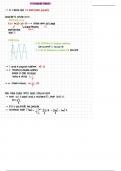Lelenotes
On this page, you find all documents, package deals, and flashcards offered by seller lelenotes.
- 3
- 0
- 0
Community
- Followers
- Following
3 items

Summary and examples of ‘First/Higher Order Differential Equations’
This document has everything you need to pass your A1 for engineering mathematics 214, every topic from, NAMELY, EXACT EQUATIONS, HOMOGENOUS DE, BERNOULLI'S EQUATION, REDUCTION OF ORFER, UNDETERMINED COEFFICIENTS, VARIATION OF PARAMETERS, . The file is concise, organized, color-coded and very neat. Ideal for most.
- Book
- Summary
- • 36 pages •
This document has everything you need to pass your A1 for engineering mathematics 214, every topic from, NAMELY, EXACT EQUATIONS, HOMOGENOUS DE, BERNOULLI'S EQUATION, REDUCTION OF ORFER, UNDETERMINED COEFFICIENTS, VARIATION OF PARAMETERS, . The file is concise, organized, color-coded and very neat. Ideal for most.

Organized summary and examples of ‘Steady-State sinusoidal Analysis’
This document has everything you need to pass your A1 for electro-techniques 214, every topic from, NAMELY, SINUSOIDAL SIGNALS, PHASORS, COMPLEX IMPEDANCE, POWER IN AC CIRCUITS and THEVENIN AND NORTON EQUIVALENT CIRCUITS. The file is concise, organized, color-coded and very neat. Ideal for most.
- Book
- Summary
- • 31 pages •
This document has everything you need to pass your A1 for electro-techniques 214, every topic from, NAMELY, SINUSOIDAL SIGNALS, PHASORS, COMPLEX IMPEDANCE, POWER IN AC CIRCUITS and THEVENIN AND NORTON EQUIVALENT CIRCUITS. The file is concise, organized, color-coded and very neat. Ideal for most.

Organized Class notes Electro-techniques 143 Electric Circuits, Global Edition
In depth, color coded and digitally written notes that clearly explain the concepts described: 1- source transformation method 2- Norton and thevenin curcuits 3- open circuit/short circuit method 4- switch off method 5- test voltage method 6- node voltage analysis (little) 7- mesh current analysis ( little)
- Book
- Class notes
- • 24 pages •
In depth, color coded and digitally written notes that clearly explain the concepts described: 1- source transformation method 2- Norton and thevenin curcuits 3- open circuit/short circuit method 4- switch off method 5- test voltage method 6- node voltage analysis (little) 7- mesh current analysis ( little)
